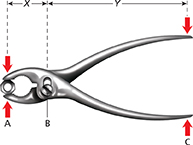CHAPTER 14 Assessment
Reviewing Content
Choose the letter that best describes the question or completes the statement.
Work is the product of
speed and force.
force and distance.
power and force.
motion and force.
Which of the following is a unit of work?
joule
watt
horsepower
newton
How much work, in N· m, is done when a 10.0-N force moves an object 2.5 m?
0.25 N•m
2.5 N•m
25 N•m
4.0 N•m
Power is equal to work divided by
time.
force.
distance.
mechanical advantage.
If a machine has a mechanical advantage much larger than 1, its output force is
much larger than its input force.
much less than its input force.
about the same as its input force.
in the same direction as its input force.
How is the work output of a machine related to its work input?
always less
always greater
always equal
always zero
A machine with a 5-N input force and a 25-N output force has a mechanical advantage of
2.
5.
20.
125.
The mechanical advantage of a pulley system depends upon
the diameter of the pulley wheels.
the length of the rope.
the number of sections of rope.
the direction of the input force.
A screw can be considered a type of
lever.
inclined plane.
pulley.
compound machine.
Which is not a simple machine?
wedge
screw
lever
fulcrum
Understanding Concepts
Does an athlete do work on a trophy as she lifts it overhead? Is work done on the trophy as she stands still holding the trophy overhead? Explain.
What is the scientific definition of power?
Questions 13–15 refer to the illustration below.

Identify the position of the fulcrum.
If X = 3.0 cm and Y = 15.0 cm, what is the ideal mechanical advantage of the pliers?
If the output force is 50.0 N and the input force is 12.5 N, what is the actual mechanical advantage of the pliers?
A machine you designed has input and output arms that pivot around a fulcrum. When the input arm is pushed down through a short distance, the output arm moves down through a longer distance. Is the output force less than, equal to, or greater than the input force?
A machine has an efficiency of 60%. What happens to 60% of the work put into the machine, and what happens to the other 40%?
Identify the simple machines in a pair of scissors.
Why would you use a single fixed pulley to lift a box if the pulley's mechanical advantage is 1?
What determines the class of a lever?
Is a screw with fewer or more threads per centimeter easier to drive into a piece of wood? Explain.





 Interactive Textbook with assessment at
Interactive Textbook with assessment at